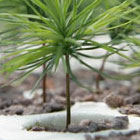 The United Nations refugee agency has pledged to plant more than 9 million trees this year in areas of human displacement where refugees have used the trees, wood, bark and leaves for survival. The effort will be coordinated with the UN Billion Trees Campaign, which has already planted 14 million seedlings since November…
The United Nations refugee agency has pledged to plant more than 9 million trees this year in areas of human displacement where refugees have used the trees, wood, bark and leaves for survival. The effort will be coordinated with the UN Billion Trees Campaign, which has already planted 14 million seedlings since November…
"The main problem in areas of displacement is deforestation as refugees and internally displaced persons need to cut and collect wood for cooking, to provide light, for construction and for natural medical ingredients and fodder," explained UN High Commissioner for Refugees (UNHCR) Environmental Senior Officer Valentine Ndibalema.
"People also cut down trees to create areas for cultivation or to sell the wood in markets and have an additional income."
The resultant damage is a major concern for host countries and local populations because the land can take years, if ever, to recover. In response, UNHCR has joined a major tree-planting campaign run by the UN Environmental Program (UNEP).
UNEP launched "Plant for the Planet: The Billion Tree Campaign" in November last year and it has so far won pledges to plant more than 960 million trees, while almost 14 million have actually been planted to date. The agency is encouraging individuals, communities, business and industry, civil society organizations and governments to take part.
The refugee agency will enlist the help of refugees themselves and their host communities as it pursues the goal of planting 9 million trees this year. Seedlings of various types of tree are being produced and will be distributed for planting around shelters and homes or for reforestation of denuded areas.
The idea for the UNEP campaign was inspired by Nobel Peace Prize laureate Wangari Maathai, whose Green Belt Movement has planted more than 30 million trees in 12 countries in Africa since 1977.



















